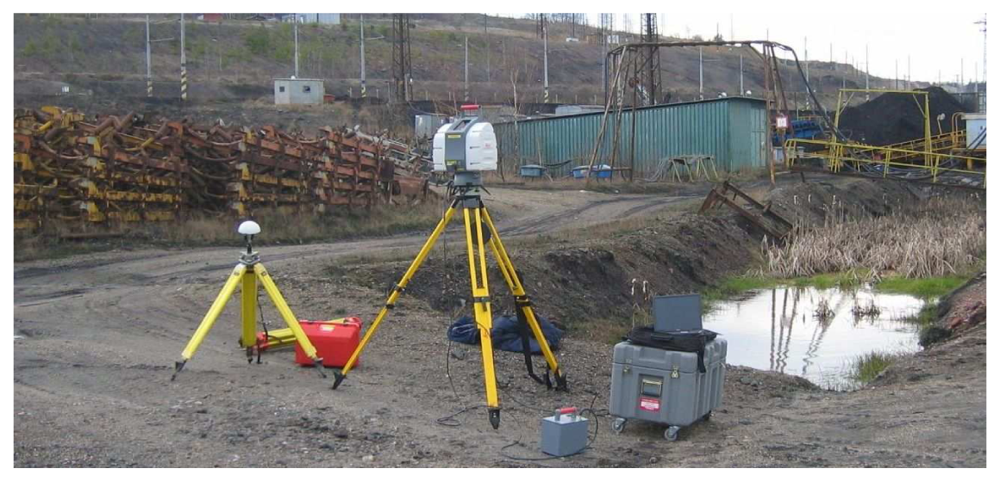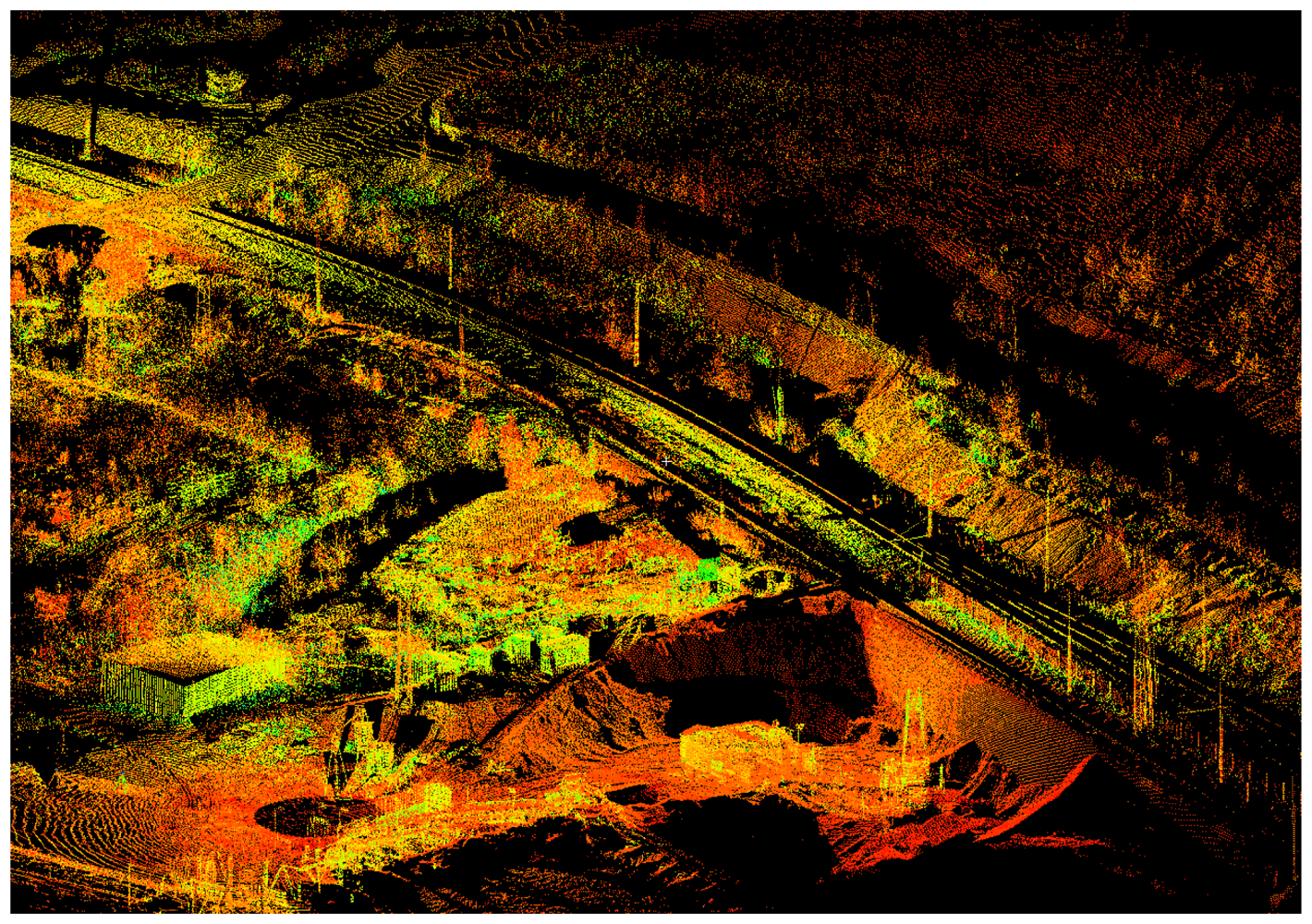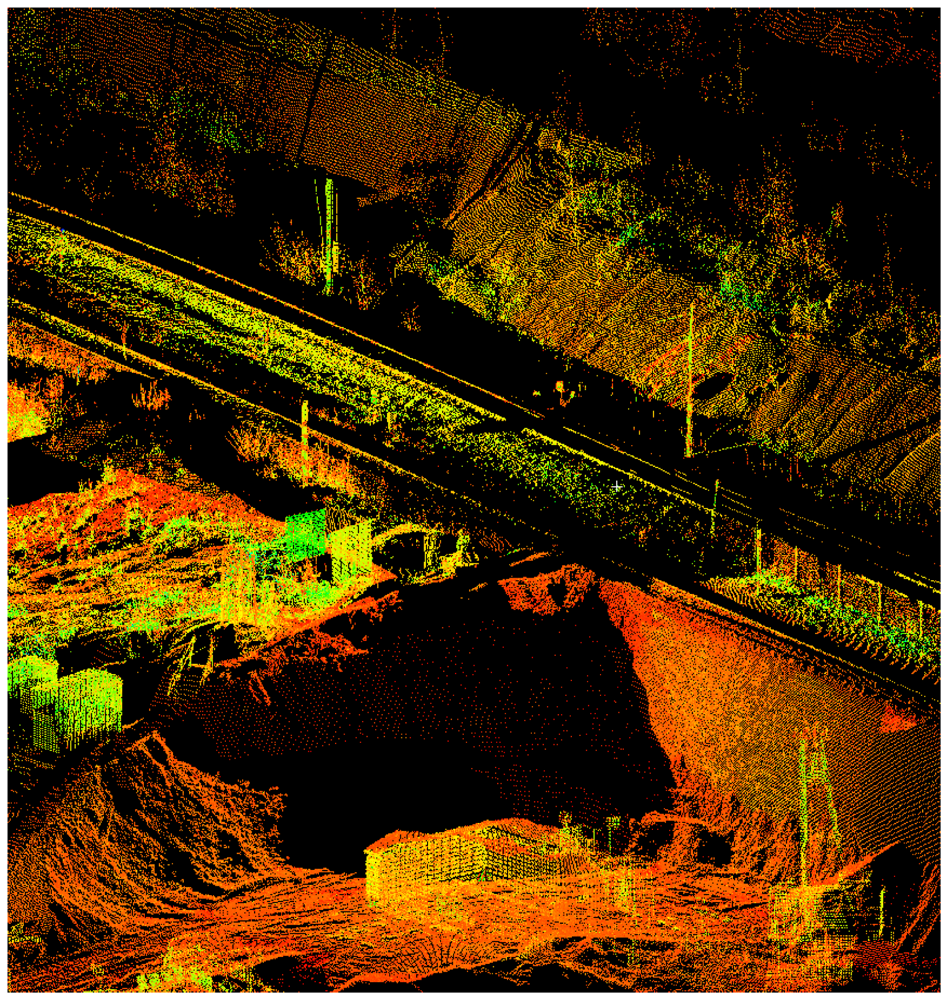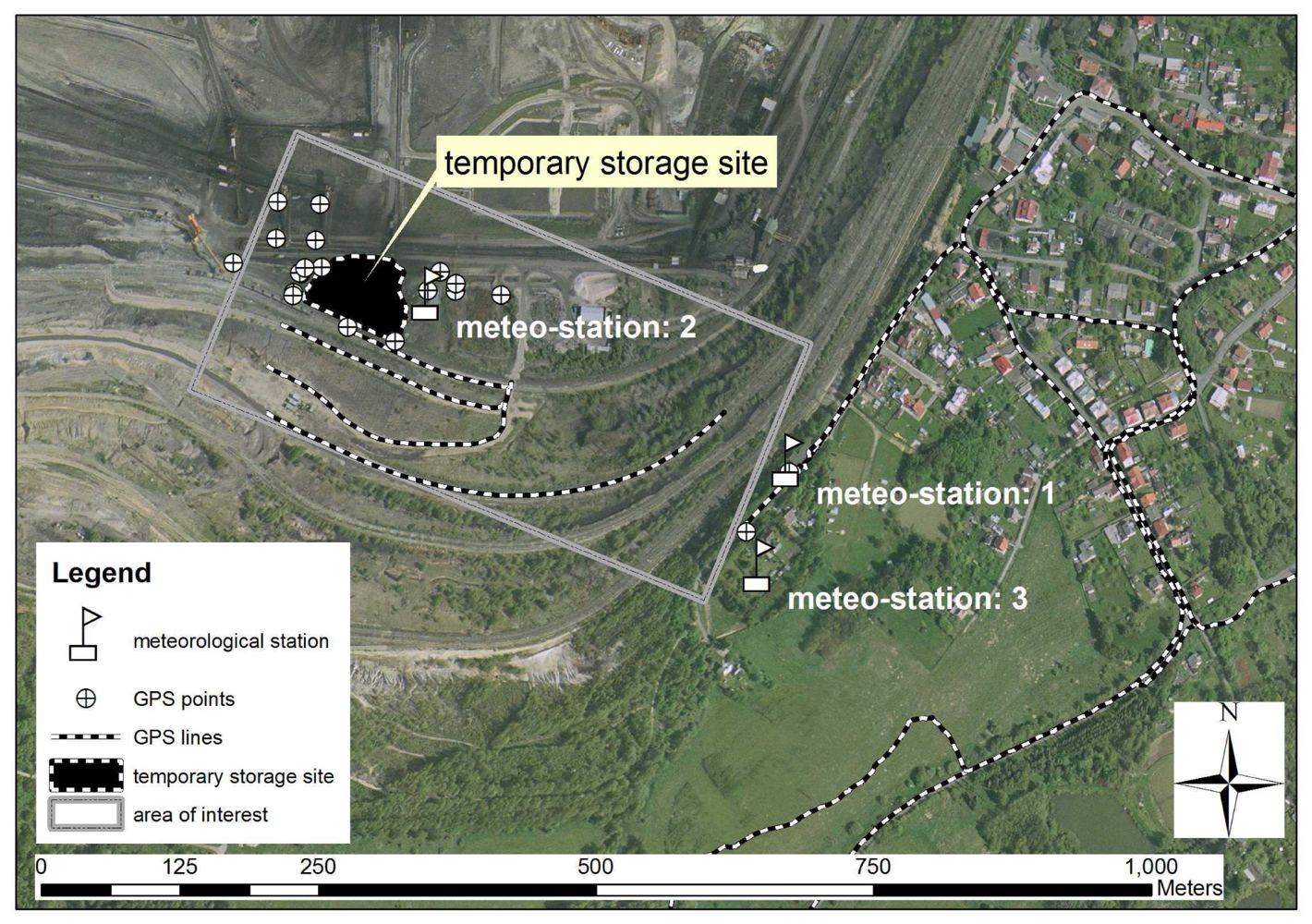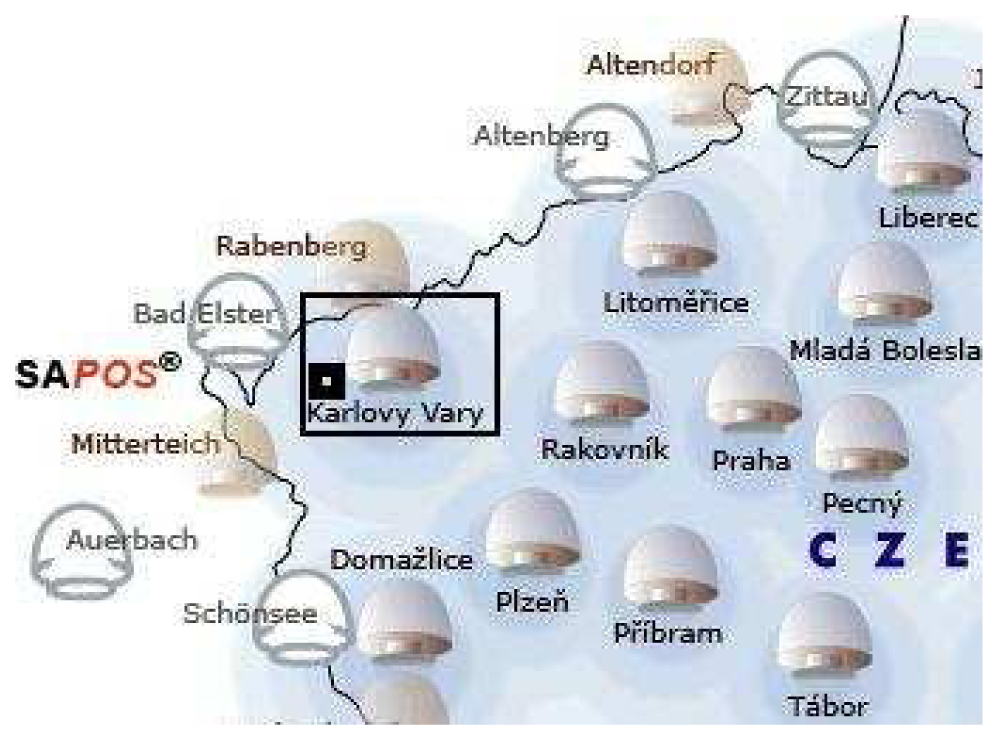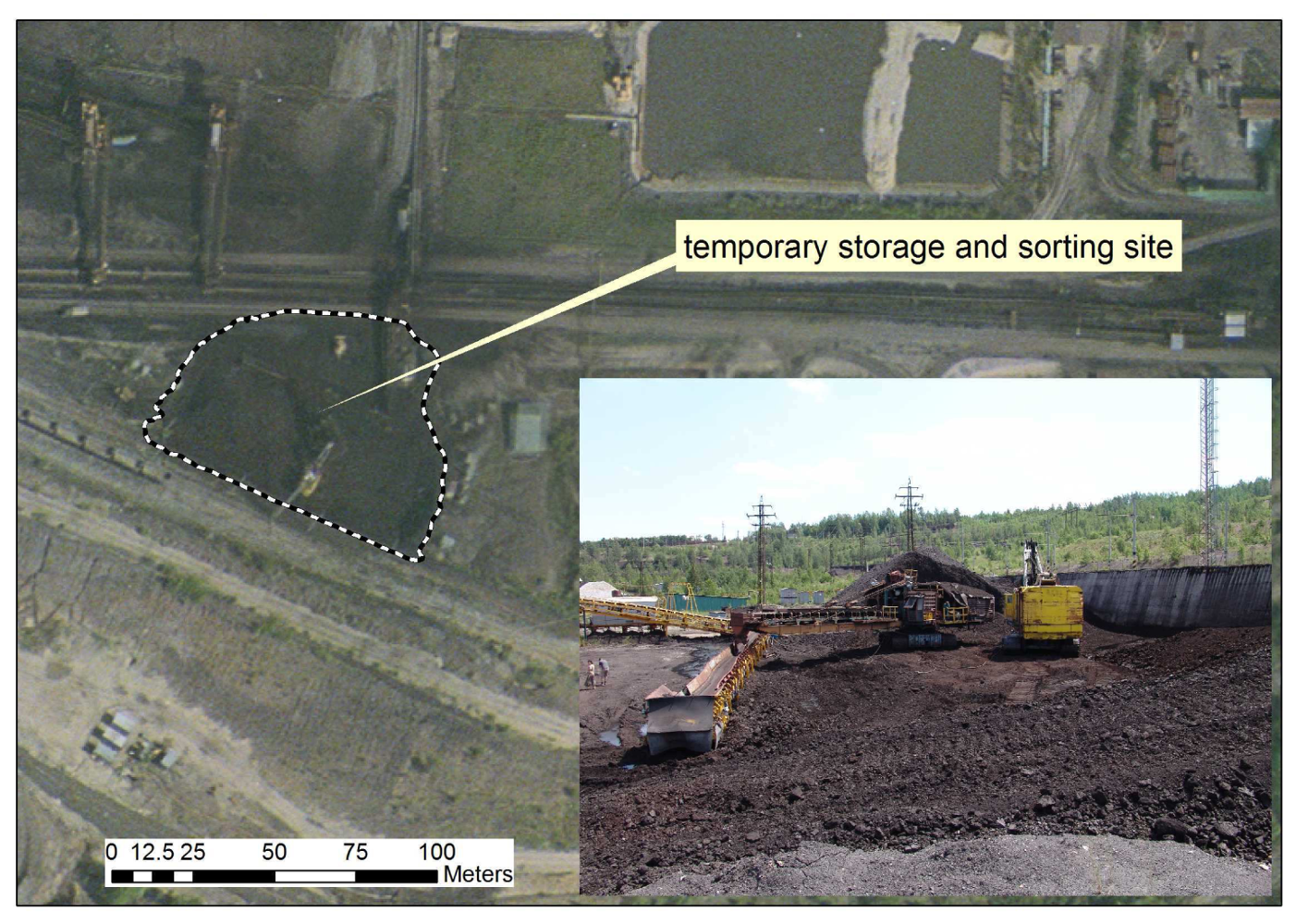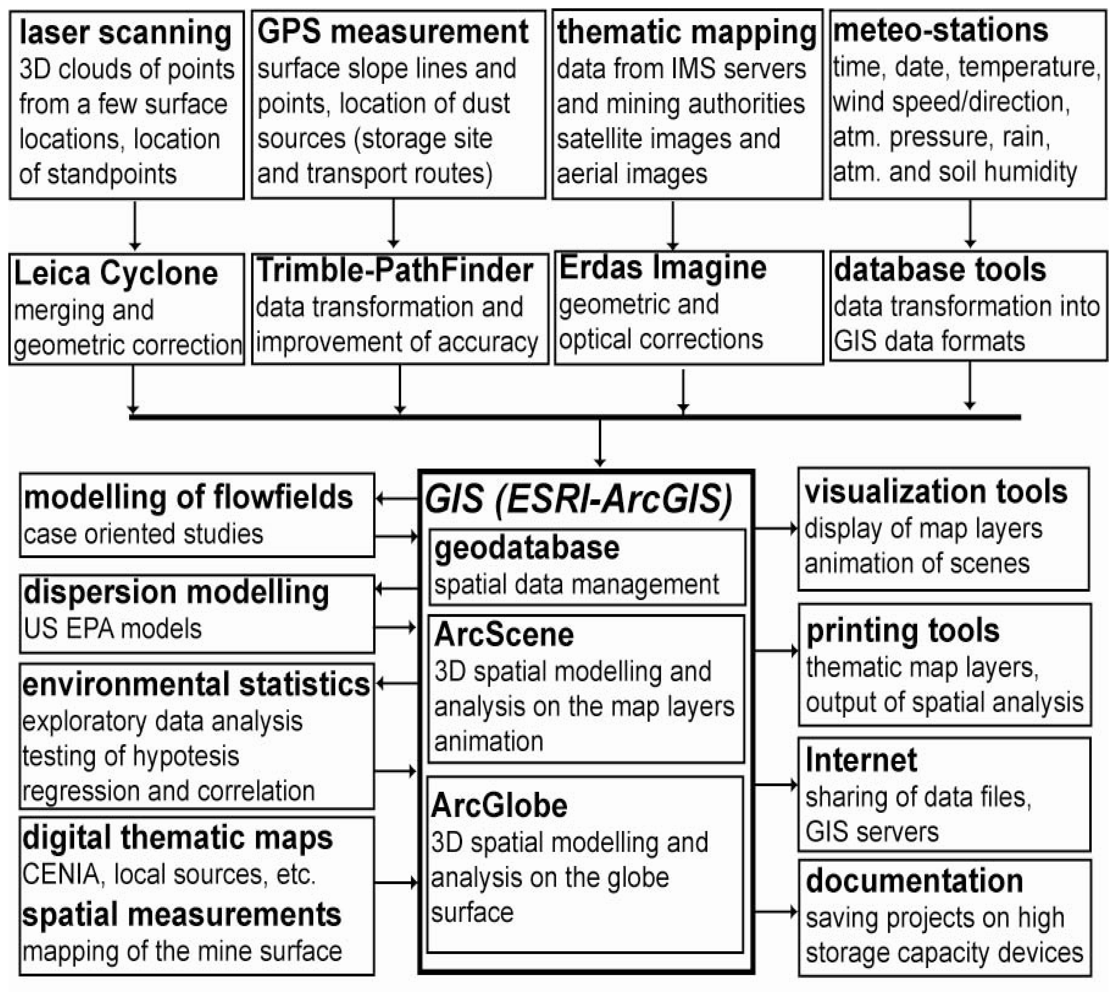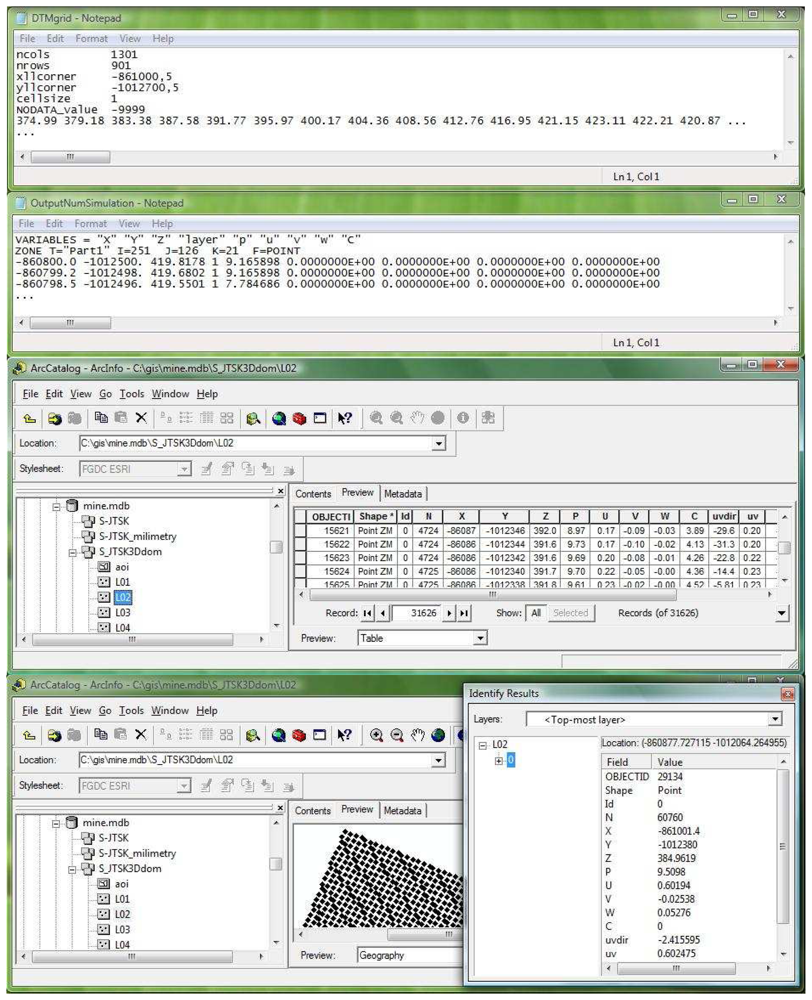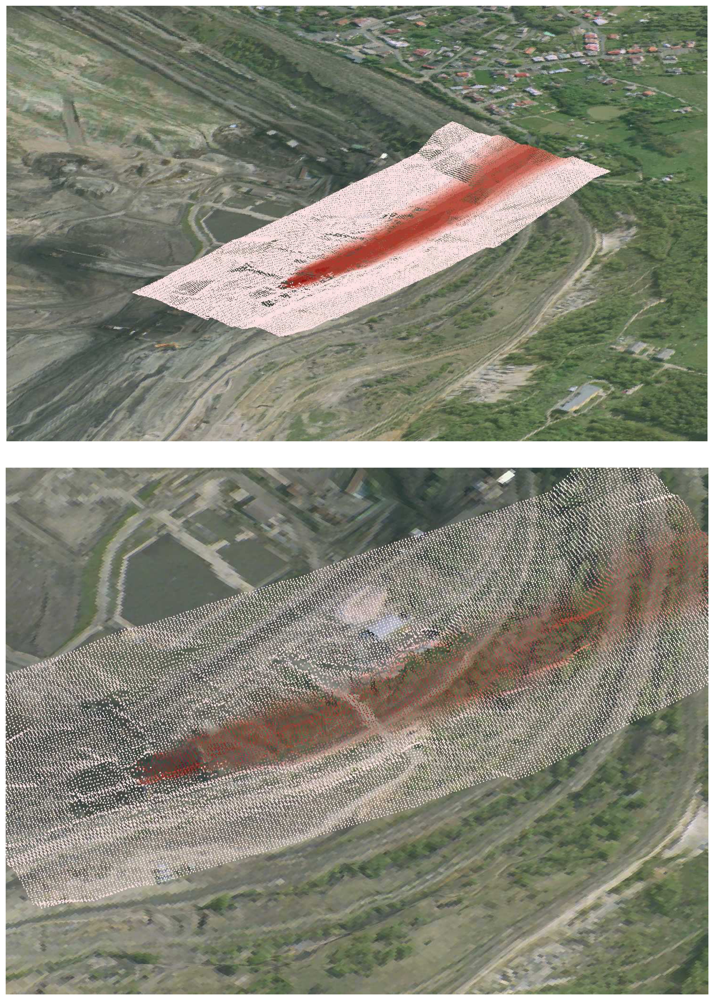3D laser scanners provided an efficient method for local 3D point cloud acquisition of the surface coal mine and its associated industrial installations. Complete coverage with point cloud data mostly requires data acquisition from multiple standpoints. In order to improve existing thematic spatial data, four scans with an average grid size of 0.2 meters were performed with a Leica HDS 3000 3D laser scanner. The selected local area of the surface coal mine is shown in
Figure 1. The temporary storage site located on the left represents the dominant dust emission source. The residential zone located approximately 500 meters from the temporary storage place is on the right side. The measurement equipment at one of the standpoints is illustrated in
Figure 2.
In order to create the required spatial data inputs for such a complex DTM construction [
7], processing of the point clouds was performed using Leica Geosystems HDS Cyclone software in cooperation with Gefos Ltd. in the Czech Republic. The final 3D point clouds for the area are shown in
Figure 3, and a detailed view of the temporary storage site is in
Figure 4.
2.5 Other data sources
Data sources for the DTM are complemented by contour lines from existing digital map sources at a scale of 1:10,000. These maps do not just cover the surface mining area, but extend the DTM to the larger area of the surface mine and its neighbouring zones. Other thematic map sources are Internet based geographic data. For this surface mine, located in the western part of the Czech Republic, Internet mapping servers based on ESRI technology (
http://geoprotal.cenia.cz and
http://mapy.kr-karlovarsky.cz) were used to add thematic map layers. In addition to the laser scanning, the local area of the temporary storage site was extended by spatial data obtained from a mining company mapping survey (transport routes, locations of the mining installations, and a set of 3D points).
Satellite images can display larger surface emission sources such as whole surface mine regions. In the case of passive optical sensors, the natural energy detected is emitted or reflected by the objects themselves or by the surrounding area being observed. Then, the spectral, spatial and temporal properties of the gathered information are analysed by the remote sensing software tools. In addition to the natural energy of the visible electromagnetic light spectrum, satellites (LANDSAT, ASTER, SPOT) can detect infrared light that human eyes cannot perceive. Bands in the infrared spectral range can be used for the discrimination of geologic rock types, soil boundaries and soil moisture content which affect the rate of surface emission sources. Relationships with known features on the ground (bare land, vegetation, urban, forest) can be found using multispectral classification. In this study, an orthorectified image from LANDSAT 7 ETM+ (192/25, RMS = 0.63 pixel, approximately 19 meters) was used to display the entire area including the surface mine and residential zones in the framework of the visualization phase.
2.6 The GIS approach
Spatio-temporal modelling including spatial analysis and extensions for the analysis of time series offers a wide range of advanced functions for data processing, visualization and digital mapping outputs [
9-
11], and thus can support environmental planning and policy making. Direct access to large volumes of data allows more complex information to be used in decision-making processes, while the ability to reach a broad audience and to generate a large number of options, scenario analyses and forecasts can help to more efficiently solve environmental problems [
12]. In the case of dust transport, insight into wind flows together with the DTM, aerial images and pre-processed data from meteorological stations and existing thematic map layers helps in the exploration of the mechanisms of dust dispersion and deposition. This approach focused on the integration of spatio-temporal data and the workflow of data processing is illustrated in
Figure 9.
The GIS project based on spatio-temporal data serves as the main data storage for numerical modelling. Data inputs for the numerical simulations contain the DTM and time series from the meteorological stations. Data outputs from numerical simulations are represented by the three dimensional domain over the DTM. The domain forms layers, which in turn contain a set of nodes. The attributes of each node include the coordinates in 3D space, the velocity vector, atmospheric pressure and the concentration of the passive pollutant. In order to import data into the GIS project, the post processing phase is focused on georeferencing of the data domain, transformation of the internal data and import into the GIS database.
2.7 The modelling approach
The dispersion of dust particles near an emission source can be described by mathematical equations based on physical principles [
13]. However, in the actual environment with a huge number of various surface objects (i.e., the temporary storage site, mining installations and buildings) and other factors (climate, soil conditions), the models reflect only basic phenomena and have to be improved through many corrections depending on the selected mining area and field measurements [
14,
15].
Due to this approximate character of the results from mathematical modelling, an alternative method is to use wind tunnels for physical modelling. These types of experiments can be performed on down-scaled models of the studied area, with simulated flow conditions similar to the conditions observed in the atmosphere. In order to validate flow fields and pollution dispersion in simplified 2-D and 3-D space, field measurements are necessary to explore all the spatio-temporal characteristics which depend on surface objects [
16].
In this paper, wind flows and pollution dispersion in atmospheric boundary layers were simulated through numerical models based on Reynolds averaged Navier-Stokes equations (RANS) in non-conservative form:
where
V =
col(
u,
v,
w) is the velocity vector,
p pressure,
ρ density.
The transport equations for concentrations of passive pollutants are:
where
Ci is the concentration of the
ith pollutant and
σ denotes the turbulent Prandtl's number. The turbulence model is based on the Boussinesq hypothesis of the turbulent diffusion coefficient:
that is represented by the sum of molecular and eddy viscosity. Thus, the final implemented algebraic turbulence model is in the form:
The parameter
fc = 0.00011
ms denotes the Coriolis parameter. The parameter
VG is the geostrophic wind. The numerical simulation was carried out with a semi-implicit finite-difference scheme [
17] extended by a number of other simulation tools focused on pollution dispersion in 3D atmospheric boundary layers [
18].
The outputs from numerical simulations were formed in the 3D domain and divided into layers with a set of spatial points. These layers are located over the area of interest. An example of data exchange by shared files is illustrated in
Figure 10. Initially, the DTM was exported into an ASCII grid as the input file for the numerical simulation of wind flows and pollutant concentrations (cell size: 1 meter; national coordinate system in the Czech Republic: S-JTSK). The outputs from numerical modelling were then backward imported into the GIS database. The text file contained 3D points (
X,
Y,
Z coordinates) and their attributes: atmospheric pressure (
p), wind speeds in the
x,
y and
z direction (
u,
v,
w), and dust concentration (
c). Finally, the GIS database (ESRI's geodatabase in ArcGIS) contained 21 point layers from the imported 3D domain located over the area of interest. The outputs from numerical simulation (values of variables:
p,
u,
v,
w and
c) were then transferred into attribute tables for subsequent processing and visualization.
2.8 Visualization of the dust transport
There are various methods for visualization that depend on available computer simulation tools. Existing visualization tools are mostly included with simulation packages as extensions or programming libraries [
19]. Some visualization tools are included directly into the user interface [
20]. Many methods are implemented in the GISs that can usually employ a two-dimensional framework included into the map layers. But, wind flows and dust transport require a more dynamic way of data processing and visualization, because the processes vary through three-dimensional space and through time. In spite of the fact that conventional GISs can handle the third dimension and time as attributes of basic geographical objects, other standalone software applications are needed to offer more advanced visualization functions. In many cases, existing GISs are extended by modules that provide visualization toolkits for 3D spatial data and time-varying data [
21]. In this instance, ArcScene in ArcGIS was used for the visualization of atmospheric pressure, wind flows and dust concentrations over the area of interest. As an example,
Figure 11 illustrates the 3D visualization of the dust concentration in one selected layer. The image is based on spatial data exported into the graphic files that allow only a limited demonstration of full functionality.
The 3D domain transferred into the GIS contains 21 layers with a height increment of 1 meter for the 15 bottom layers, and a height increment of 100 meters for the 6 upper layers. For example, the 2 bottom layers with the prediction map of dust concentration over the area of interest are shown in
Figure 12. The first bottom layer (L1) is 1 meter over the DTM, and the second layer (L2) is 2 meters over the DTM. In order to study wind erosion processes over the coal stockpiles in a more precise way,
Figure 13 illustrates a detailed view of the first bottom layer over the temporary storage and sorting site. The arrows show the wind direction and wind speed over the stockpiles. Vertical drift is illustrated by the prediction map in the background.
3. Discussion and suggested future research
This study describes the extension of the capabilities for spatio-temporal analysis, with an emphasis on physically based dust transport and coupling with GIS. This more precise numerical simulation of dust transport requires a more complex DTM construction. This DTM is extended by additional surface objects, some spatial data sources and field measurements, which are then used for construction in the GIS environment. At the same time, various results can be compared depending on accuracy and capture efficiency.
The use of 3D laser scanners enables more accurate continuous mapping of smaller areas for the DTM, but multiple scans from different locations are required to obtain complete data sources from parts that are obscured. Also, more powerful software tools are needed to bring the clouds of spatial points into a common reference system and to eliminate incorrect spatial points, originating for example from vegetation, pylons and mining equipment. In general, a reduced data set is first used for integration into the GIS database in order to create the DTM. Then, the DTM based on point clouds captured with average grid 0.2 meters are a necessary spatial data source for representing the vertical slopes of the surface mines.
GPS measurements with a final accuracy of 0.5 m after the postprocessing phase complement the data from 3D laser scanners. Besides capturing other 3D points and 3D lines for the DTM, the GPS was used for the localization of other surface objects for thematic mapping (i.e. boundaries of the temporary storage site with its coal stockpiles, actual transport routes, coordinates of meteorological stations), and also to complement existing thematic maps of the neighbouring residential zones.
Other 3D spatial data, mostly based on 1:10,000 thematic maps, are not used for the DTM which supports the numerical simulations, but are dedicated to the overall visualization of larger areas extended by data from numerical modelling and spatial analyses. Also, the aerial images and satellite images from Landsat 7 ETM+ are used to more realistically display the area of interest.
Pre-processed data from the DTM and time series of the wind speed and direction from the local meteorological stations are used as data inputs into the numerical simulation based on RANS equations. The simulation output represents a 3D domain of nodes with defined velocity vectors, atmospheric pressure values and dust concentrations. The spatial projection of the 3D domain over the DTM enables the identification of areas of higher wind speed with vertical drift near the stockpiles, where dust emissions are most likely to occur. In addition to the spatial linkage of the simulation outputs with the DTM, this integration of thematic map layers and aerial images in the GIS environment allows new ways to interpret results. Thus, more precise terrain mapping of the surface by GPS and classification of the aerial images can help to improve estimates of dust emission and the modelling of dust transport. Until recently, a number of studies focused on flows over simplified objects such as stockpiles or man-made barriers have been carried out using numerical modelling or simulations in wind tunnels [
22,
23]. However, it is difficult to apply these partial results in the general scale of wind flow spatio-temporal modelling over the DTM in real conditions. Thus, to improve model accuracy, more complex measurements of emission processes which depend on meteorological conditions and soil properties are needed to test other effects and to propose more efficient procedures for decreasing dust emissions and deposition.
In order to implement spatio-temporal modelling in the framework of dust transport risk assessment, a standalone application in the GIS environment needs to be developed that can share a wide range of existing spatial data and provide on-line numerical simulations, spatial analysis of dust concentrations and final visualization. Various case studies could then be tested by mining authorities and local agencies, in order to minimize the actual coal emissions and transport.

